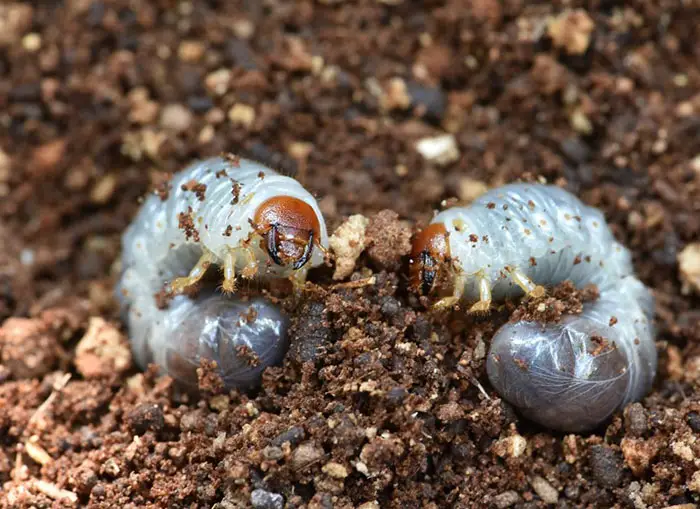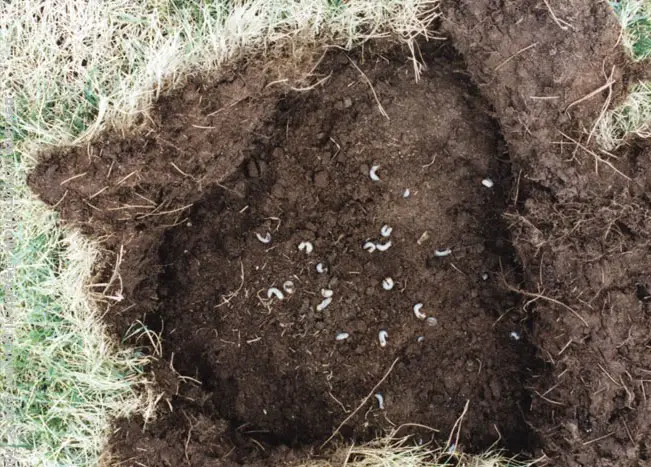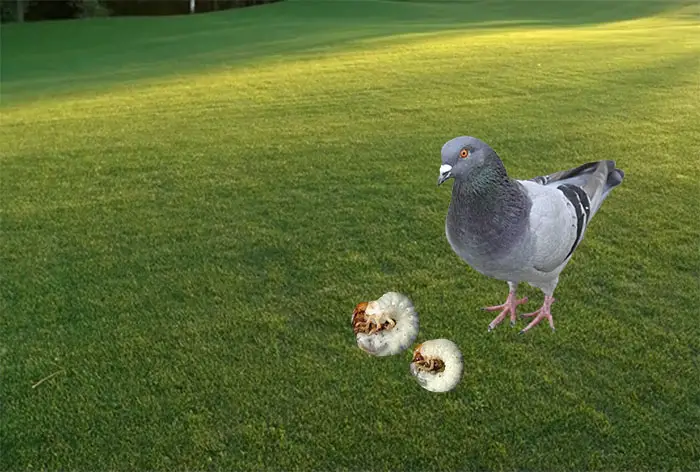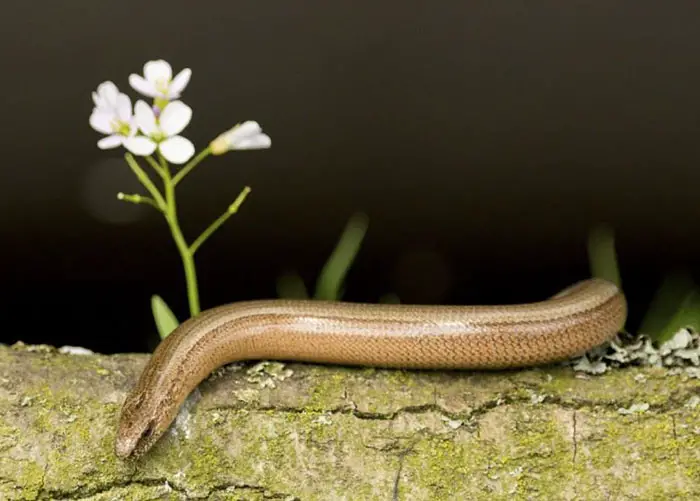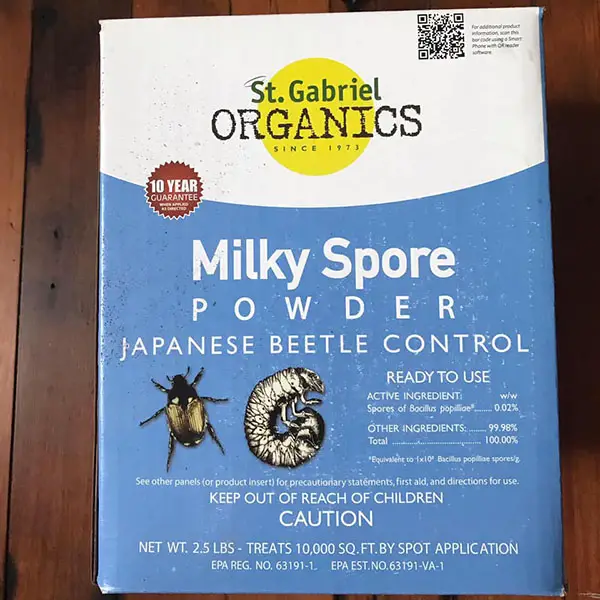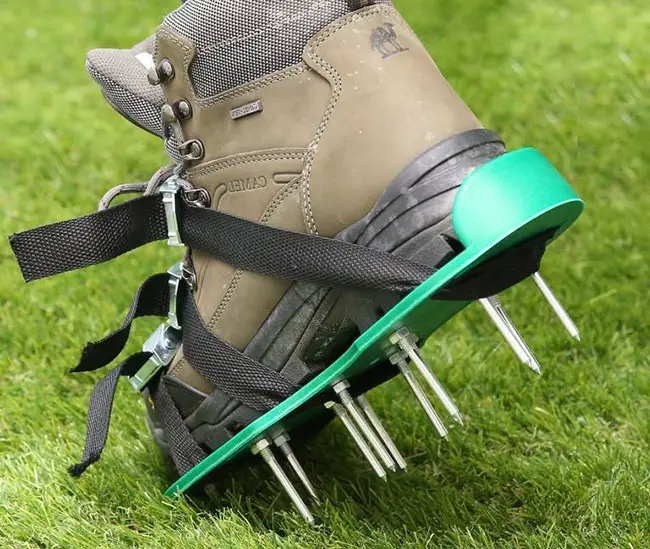White grubs are also known as lawn grubs or grub worms. They are small, worm-looking larvae growing in soil. They are mostly white, and their length is around one-half to one inch long.
Grub worm actually looks nothing like an earthworm. A grub worm is fat and short. Most of the time, grubs are three-quarters of an inch long and ¼ inch in diameter. The size varies throughout the year, but this is usually in the middle of the spring.
What are the most common types of lawn grubs?
The most common types of white grubs are cutworms and white grubs. White grubs are beetle larvae, and cutworms are larvae of moths. They are usually longer than white grubs and brown or tan colored, while white grubs are white (hence their name).
They eat the lawn and destroy healthy grass over time. They can have a devastating effect on your lawn if you will not annihilate their habitation immediately.
This is how they work. They hatch eggs during spring, feeding on the root of the grass. After they have eaten much, they will penetrate enough to weaken the grass. Your lawn becomes prone to drought, wilting, or drooping.
They will carry on this activity until summer ends. By July or early August, they will lay eggs once again. They will dig six inches below the dir, come out again during springtime, and repeat the process.
White grubs mostly attack the roots of grass or ornament plants. These small insects often infest your lawn in large groups. This means there are a lot of them attacking together. This is harmful, especially to an unhealthy lawn.
Things That You Should Know about Grub Worms
To deal with the problem with grubs on your lawn, there are some things that you need to know about them that will help you treat and control them much easier.
They Live Underneath The Soil
The first thing that you should know about grub worms is that they live just underneath the surface of your soil. You won’t really find them during the day unless you are looking for them. You may have to dig through the top inch or two of the soil before you start exposing them.
Most of the time, they are just below the surface. Also, grub worms are nocturnal, so they can come out at night and crawl along the soil’s surface. It is too risky because there are a lot of natural predators that would like to eat them.
They Hatch In The Fall
They start in your grassroots in the fall, and then they hibernate over the winter. In the spring, you will notice a lot more of your grubs and lawn is being invaded by them.
They get the biggest about the end of the spring. In the early or mid-summer, they go into molting, and then they emerge as adult beetles. The best time to kill grub worms is when they are large grubs.
They Will Eat Out The Roots On Your Lawn
Usually, they like to eat the taproot on your grass. After they eat out most of the roots, it takes your grass a while to heal itself. If, for some reason, your grass is not getting enough water, it will die very quickly.
Also, when there are large concentrations of grub worms, they will eat so much of your grassroots that your grass will die completely. When there are only a few grubs, it is lethal on your grass.
They slow down the growth of your grass and not killing it. Most lawns have grubs in them, but a few lawns have a lot of grubs, and when they do, it can kill your grass.
How Do White Grubs Affect Your Lawn?
White grubs can have a very devastating effect on your lawn. If you do not take care of them immediately after you realize there is a problem, they can attack the roots and ornamental parts of your lawn, and within a matter of a few months, they can destroy it.
Lawn grubs typically will hatch their eggs during the spring. These eggs are laid by beetles, or crane flies at the end of the fall. During the early spring, they hatch and come to the surface of your grass to feed on the tender shoots and to the roots of your lawn.
How Long Does It Take Grubs to Destroy Your Lawn?
It does not take a long time for grubs to destroy your lawn. Often, as soon as you realize you have a problem, you should get the problem treated. If you do not, then you could have more serious problems.
These problems will include major repairs to your lawn or replacing it in the fall if you do not treat your lawn for grubs in the spring.
If you have a serious problem with lawn grubs, it is also possible that you will have problems with gophers and moles digging through your soil. You may also even have birds that come down and pick your soil to pieces while they are looking for grubs to eat.
Preemptive action is the best way to prevent these problems. If you know that your neighborhood has problems with grubs, do not hesitate to put down any grub control during the late spring. This will prevent you from having as many problems with lawn grubs later on.
How Can I Tell If There Are Lawn Grubs In My Yard?
It is hard to tell right away if you have them on your lawn. It is not until patches of grass start dying, and by then, it’s too late. It is important to keep your lawn healthy, so it can fight off these kinds of intruders and check in the early spring and late fall for any signs of lawn grubs.
Nonetheless, there are many ways in which you can tell if your lawn has grubs.
Grass Turn Yellow
First of all, grubs will cause your grass to turn slightly yellow. When they are eating the roots, then your lawn is going to get less water. Grubs will also come out at night and eat grass that is touching the surface of the soil. Grubs have chewing mouthparts that allow them to digest your grass, and they will turn green after they have feasted on your lawn.
Grass Rips Out
Another sign is if the grass rips out easily. Usually, this is because the lawn grubs will eat some of the deepest roots first. And there isn’t much to hold your grass in the place.
When the lawn starts wilting or drying out in different areas (spots throughout the lawn and not just a few spots where dogs urinated), the surest way to tell is to check your soil regularly. Early each spring, rake down into your grass and see if you can spot any grubs.
If you have had a bad infestation of grubs in a sod lawn, you may have three-quarters of an inch of dead sod in areas where the grubs have been. You typically don’t see the spots until the end of the summer or the beginning of the fall.
By this time, it is probably too late in the year to treat your lawn for grubs. But you can treat your lawn for them early in the spring next year. You may even want to consider using a pest control company.
Bird or Gophers
If you found birds that seem to like to come to your lawn and picking holes in your dirt, most likely there are lots of good food for them to get in your lawn. They are not actually trying to damage your lawn. They are just trying to get lunch. And they really like eating grubs.
Gophers also like grubs. If you have gophers digging up your lawn and you find many gopher holes in your lawn, then it is a sign of grubs in your lawn.
If you are experiencing any of these signs, it is a good idea for you to check for grubs. To do this, I usually go to the worst lawn area and pull up dead sod in that area or on the edge of that area, and I look for white grubs. These grubs will be ½ to ¾ inches in length.
They are white and do not look like an earthworm because they are short and stout. If you do find them, you will want to treat your lawn immediately.
How to Treat Your Lawn for Grubs
You spend thousands of dollars literally to have a healthy, green lawn only to find it wither away before your eyes. You tried every best possible way to irrigate, aerate and fertilize it to no avail. Chances are, your lawn has grub infestation.
If you have such an issue, these are the basics of lawn care and lawn pest control.
Step 1
You must understand that having grubs in the soil is normal for most of the yards. Before you implement a grub-removal program, you must determine the extent of your lawn’s grub infestation. You can do this by carefully cutting a 6” X 6” sample turf on your lawn.
Cut as many samples from different parts of the lawn. If the sample turf contains 2-3 lawn grubs per sample, this means your lawn needs treatments. You can replace the turf after inspecting it.
Step 2
Know the species of grubs that infest your lawn. Identification of beetle species helps determines the program you implement. Three common beetle species infest lawns: the June beetle, the European Chafer, and the Japanese beetle.
Step 3
Should your lawn really warrant a treatment, then choosing the right time of application is crucial. Grubs have a three-year cycle before they pupate and turn into adult beetles. Once they are hatched in spring, they start feeding on roots of plants and other decaying matter.
During the fall, they start digging deeper into the soil and remain there all winter. As the soil starts to warm up in the spring, they return to the surface with a voracious appetite.
The second year of their life-cycle is the most destructive part of their life-cycle. Your lawn is filled with grubs that are in various stages of their life-cycle.
Treating, therefore, in spring is somehow less effective since the larger grubs have done their spring feeding and are difficult to kill. Experts advise that lawns should be overseeded during spring instead of on damaged areas while waiting for fall, where it is the best time to apply the pesticide.
Step 4
Ask your salesman for the right kind of pesticide to apply. Since there are no permanent products that remain on the shelf for a long time, it is expected that they will introduce you to new ones every year. Grub insecticides change their formulation now and then.
How to Get Rid of Grub Worms in Your Lawn
Here are some methods that you can use to get rid of grub worms.
Apply a Grubs Killer
The first method that will help you get rid of lawn grubs is to apply a grub killer. Make sure that the type of grub you have is listed on the label for the pesticide. If you can, it is better to use a selective pesticide than a non-selective one.
Pesticides that are also IGR ( insect growth regulators) are safer to use around pets and better for the environment. If you have a layer of fat in your lawn, you probably want to get rid of it before you apply the pesticide.
Iron Maiden Approach to Grub Control
This method is completely organic or at least chemical-free. This method is called the spikes of death. It won’t eliminate all the grubs in the soil, but it will get rid of a significant percentage of them.
Basically, you need to wear lawn aerator shoes on your feet and walk across the lawn multiple times. Since these shoes have 2-inch spikes on the bottom, spaced every half of an inch, they can be pretty effective at killing the Grubs and turning them into useful plant fertilizer.
Using Nematodes
I have also heard people say that using beneficial nematodes is a great way to get rid of the grubs. Nematodes are basically small worms that can be parasitic to a lot of grubs. Nematodes work best when there is a large population of grubs to serve as hosts on your lawn. The nice part is that these nematodes typically don’t affect other animals.
Milky Spore Disease
When you’re learning how to get rid of grub worms, another method that you can use is to use milky spore disease. The milky spore disease also works best when there is a large population in a small area. Milky spores can kill the grubs and can remain in your soil for quite a while. As long as it is in your soil, it will help deter future grub infestations.
Use Lawn Dethatcher or Power Rake
I am surprised that I have not found this method mentioned anywhere else, but I know that it works because whenever I power rake a lawn with grub problems, I find lots and lots of dead grubs mixed in with a thatch. Most of the time, the grubs will live in the thatch layer of your lawn.
By simply removing the thatch, you’re going to be able to remove at least half of the grubs in your lawn. Not only that, but they will also be more vulnerable to natural predators such as birds if you remove the protective layer of thatch from the soil. Also, after you rake a lawn, the optimal times are received and fix the damage caused by the grubs.
How to Use Aerator Shoes to Kill White Grubs
My favorite method of killing lawn grubs actually works. It doesn’t involve the use of chemicals, and it is 100% organic. The easiest way to bring down grub populations is to walk across your lawn with a pair of spiked aerating shoes.
Now, I am not a big advocate of spiked shoes for aerating your lawn. Using a mechanical lawn aerator is far easier and more effective than using shoes to aerate with. However, they do a good job of killing grubs.
This is because they usually have 2-inch spikes on the bottom and spikes about half an inch apart from one another. Most grubs tend to live between 1 inch to 3 inches below the surface of your soil. They feed on the roots of your grass.
You can get rid of grubs in your soil by putting on a pair of lawn aerator shoes and walking across the lawn. Make sure that you walk across the areas where you have grubs three or four times. You really want to make sure to kill as many of them as possible.
Even though you won’t kill all the grubs in your lawn, if you can get rid of 30 to 40%, then your lawn should start to look better and repair itself.
Make sure that if you have grubs in the lawn that you keep watering your lawn regularly. As long as your grass doesn’t dry out, it will probably stay alive. If your grass dies because of grubs that have eaten all the deep roots, then you will have to tear out that part of your lawn and replace it.
It is much cheaper to spend a little extra money on water to keep it green until the grubs have left. Then, you want to put down a grub killer containing an IGR ( insect growth regulator ) to keep grub eggs from hatching or to keep grubs from molting into adults.
Hopefully, you’re treating it soon enough. You can prevent them from doing any worse damage to your lawn. You may also want to apply the treatment twice to kill unhatched grubs, which will be immune to poison the first time you apply it.

